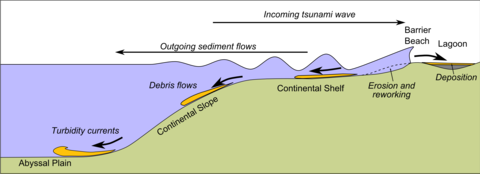Tsunami
As Tsunamite are sedimentary rocks called, which are composed of the deposits formed during a tsunami have emerged. These deposits are characterized by a sharply delimited, mostly several meters thick sediment layer with chaotically embedded breccias and lithoclasts (rock fragments, blocks) that can be derived from the shallow marine area and the adjacent beach area. An approaching tsunami wave leads to the destruction of rocks and coral reefs in the shallow marine area and the entire beach area. The tsunami wave that then floods back erodes large areas of the beach and shallow sea areas, sometimes several meters deep, and takes the sediments with it to areas further away from the coast.
Depending on the morphology of the sea basin, the intensity of the wave movement and the size of the objects carried along, tsunamites can be found in the shelf area , on the continental slope and in the deep sea . The grain size and the thickness of the deposits usually decrease with distance from the coast . In the hinterland of the beach, tsunami-induced sediments can also be deposited in shallow lagoons as a result of extensive flooding. On the hanging wall , tsunamites gradually return to the normal sedimentation of the respective deposit area due to the highly turbulent water movements over sediments with a storm surge character ( tempestite ) that last for several days .
Individual blocks of paleotsunamites (tsunamites that were deposited in the past) can weigh up to 200 tons and are preferred to be found in the Indian Ocean and Mediterranean .
The term was introduced in the late 1980s and found its way into geological terminology in the years that followed.
Tsunamites can be used for the allostratigaphic classification of sediments due to the sharp time limit of the deposition event .
Individual evidence
- ^ Definition of tsunami , accessed on May 28, 2012.
- ^ Kelletat - DFG final report , accessed on May 28, 2012.
- ↑ G. Shanmugam: Deep-water processes and facies models. Implications for sandstone petroleum reservoirs. (= Handbook of petroleum exploration and production. Volume 5). Elsevier, Amsterdam 2006, ISBN 0-444-52161-5 , p. 162.
Web links
- Michael Montenari: giant tsunami wave over Pfrondorf. In: Press Service Research News. 07/2004. ( uni-tuebingen.de ( Memento from March 20, 2005 in the Internet Archive ))
literature
- S. Bondevik, JI Svendsen, J. Mangerud: Tsunami sedimentary facies deposited by the Storegga tsunami in shallow marine basins and coastal lakes, western Norway. In: Sedimentology. 44, 1997, pp. 1115-1131.
- J. Bourgeois: Geologic effects and records of tsunamis. In: AR Robinson, EN Bernard (Ed.): The Sea. Volume 15: Tsunamis. Harvard 2009, ISBN 978-0-674-03173-9 , pp. 53-91.
- AG Dawson, S. Shi: Tsunami deposits. In: Pure and Applied Geophysics. 157, 2000, pp. 875-897.
